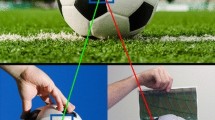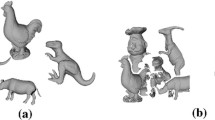Abstract
During the last years a wide range of algorithms and devices have been made available to easily acquire range images. The increasing abundance of depth data boosts the need for reliable and unsupervised analysis techniques, spanning from part registration to automated segmentation. In this context, we focus on the recognition of known objects in cluttered and incomplete 3D scans. Locating and fitting a model to a scene are very important tasks in many scenarios such as industrial inspection, scene understanding, medical imaging and even gaming. For this reason, these problems have been addressed extensively in the literature. Several of the proposed methods adopt local descriptor-based approaches, while a number of hurdles still hinder the use of global techniques. In this paper we offer a different perspective on the topic: We adopt an evolutionary selection algorithm that seeks global agreement among surface points, while operating at a local level. The approach effectively extends the scope of local descriptors by actively selecting correspondences that satisfy global consistency constraints, allowing us to attack a more challenging scenario where model and scene have different, unknown scales. This leads to a novel and very effective pipeline for 3D object recognition, which is validated with an extensive set of experiments and comparisons with recent techniques at the state of the art.


















Similar content being viewed by others
Notes
The dataset together with ground-truth information can be downloaded at http://www.dsi.unive.it/~rodola/data.html.
Matlab code for infection-immunization dynamics is available at http://www.dsi.unive.it/~rodola/sw.html.
References
Ahn, Y. K., Park, Y. C., Choi, K. S., Park, W. C., Seo, H. M., & Jung, K. M. (2009). 3d spatial touch system based on time-of-flight camera. WSEAS Transactions on Information Science and Applications, 6, 1433–1442.
Aiger, D., Mitra, N. J., & Cohen-Or, D. (2008). 4-points congruent sets for robust surface registration. ACM Transactions on Graphics, 27(3), 85.
Akagündüz, E., Eskizara, O., & Ulusoy, I. (2009). Scale-space approach for the comparison of HK and SC curvature descriptions as applied to object recognition. In Proc. of the 16th IEEE international conference on image processing, ICIP’09, Piscataway, NJ, USA (pp. 413–416).
Albarelli, A., Rota Bulò, S., Torsello, A., & Pelillo, M. (2009). Matching as a non-cooperative game. In: ICCV 2009: Proc. of the 2009 IEEE international conference on computer vision. Los Alamitos: IEEE Comput. Soc.
Albarelli, A., Rodolà, E., & Torsello, A. (2010a). A game-theoretic approach to fine surface registration without initial motion estimation. In 2010 IEEE conference on computer vision and pattern recognition (CVPR) (pp. 430–437). doi:10.1109/CVPR.2010.5540183.
Albarelli, A., Rodolà, E., & Torsello, A. (2010b). Loosely distinctive features for robust surface alignment. In ECCV 2010—11th European conference on computer vision (pp. 519–532).
Albarelli, A., Rodolà, E., Bergamasco, F., & Torsello, A. (2011). A non-cooperative game for 3d object recognition in cluttered scenes. In 3DIMPVT (pp. 252–259).
Albarelli, A., Rodolà, E., & Torsello, A. (2012). Imposing Semi-Local geometric constraints for accurate correspondences selection in structure from motion: a Game-Theoretic perspective. International Journal of Computer Vision, 97, 36–53. doi:10.1007/s11263-011-0432-4.
Bariya, P., & Nishino, K. (2010). Scale-hierarchical 3d object recognition in cluttered scenes. In IEEE conference on computer vision and pattern recognition, CVPR 2010 (pp. 1657–1664).
Borrmann, D., Elseberg, J., Lingemann, K., Nüchter, A., & Hertzberg, J. (2008). Globally consistent 3d mapping with scan matching. Robotics and Autonomous Systems, 56, 130–142.
Chen, C. S., Hung, Y. P., & Cheng, J. B. (1999). RANSAC-based DARCES: a new approach to fast automatic registration of partially overlapping range images. IEEE Transactions on Pattern Analysis and Machine Intelligence, 21(11), 1229–1234.
Chen, H., & Bhanu, B. (2007). 3d free-form object recognition in range images using local surface patches. Pattern Recognition Letters, 28, 1252–1262.
Chua, C. S., & Jarvis, R. (1997). Point signatures: a new representation for 3d object recognition. International Journal of Computer Vision, 25, 63–85.
Chum, O., & Matas, J. (2005). Matching with PROSAC—progressive sample consensus. In Proceedings of the 2005 IEEE computer society conference on computer vision and pattern recognition (CVPR) (pp. 220–226). Washington: IEEE Comput. Soc.
Frome, A., Huber, D., Kolluri, R., Bülow, T., & Malik, J. (2004). Recognizing objects in range data using regional point descriptors. In ECCV 2004, 8th European conference on computer vision (pp. 224–237).
Ghosh, D., Amenta, N., & Kazhdan, M. M. (2010). Closed-form blending of local symmetries. Computer Graphics Forum, 29(5), 1681–1688.
Horn, B. K. P. (1987). Closed-form solution of absolute orientation using unit quaternions. Journal of the Optical Society of America. A, Online, 4(4), 629–642.
Johnson, A. E., & Hebert, M. (1999). Using spin images for efficient object recognition in cluttered 3d scenes. IEEE Transactions on Pattern Analysis and Machine Intelligence, 21(5), 433–449. http://doi.ieeecomputersociety.org/10.1109/34.765655.
Lowe, D. G. (1999). Object recognition from local scale-invariant features. In Proc. of the international conference on computer vision (pp. 1150–1157).
Lowe, D. G. (2003). Distinctive image features from scale-invariant keypoints. International Journal of Computer Vision, 20, 91–110.
Mian, A. S., Bennamoun, M., & Owens, R. (2006). Three-dimensional model-based object recognition and segmentation in cluttered scenes. IEEE Transactions on Pattern Analysis and Machine Intelligence, 28, 1584–1601.
Mian, A. S., Bennamoun, M., & Owens, R. (2010). On the repeatability and quality of keypoints for local feature-based 3d object retrieval from cluttered scenes. International Journal of Computer Vision, 89, 348–361.
von Neumann, J., & Morgenstern, O. (1953). Theory of games and economic behavior. Princeton: Princeton University Press.
Newman, T. S., & Jain, A. K. (1995). A system for 3d cad-based inspection using range images. Pattern Recognition, 28(10), 1555–1574.
Novatnack, J., & Nishino, K. (2008). Scale-dependent/invariant local 3d shape descriptors for fully automatic registration of multiple sets of range images. In Proc. of the 10th European conference on computer vision (pp. 440–453). Berlin: Springer.
Pelillo, M., & Torsello, A. (2006). Payoff-monotonic game dynamics and the maximum clique problem. Neural Computation, 18, 1215–1258.
Pottmann, H., Wallner, J., Huang, Q. X., & Yang, Y. L. (2009). Integral invariants for robust geometry processing. Computer Aided Geometric Design, 26(1), 37–60. doi:10.1016/j.cagd.2008.01.002.
Rota Bulò, S., & Bomze, I. M. (2011). Infection and immunization: a new class of evolutionary game dynamics. Games and Economic Behavior, 71(1), 193–211.
Rota Bulò, S., & Pelillo, M. (2009). A game-theoretic approach to hypergraph clustering. In Advances in neural information processing conference (NIPS2009) (Vol. 22, pp. 1571–1579).
Salti, S., Tombari, F., & di Stefano, L. (2011). A performance evaluation of 3d keypoint detectors. In: International conference on 3D imaging, modeling, processing, visualization and transmission (3DIMPVT) (pp. 236–243). New York: IEEE Press.
Shashua, A., Zass, R., & Hazan, T. (2006). Multi-way clustering using super-symmetric nonnegative tensor factorization. In European conference on computer vision (pp. 595–608).
Sun, Y., Paik, J., Koschan, A., & Abidi, M. A. (2003). Point fingerprint: a new 3-d object representation scheme. IEEE Transactions on Systems, Man and Cybernetics, 33, 712–717.
Tombari, F., Salti, S., & di Stefano, L. (2010). Unique signatures of histograms for local surface description. In ECCV 11th European conference on computer vision (pp. 356–369).
Weibull, J. (1995). Evolutionary game theory. Cambridge: MIT Press.
Acknowledgements
We wish to thank Dr. Samuele Salti for contributing code to compute SHOT descriptors, Prof. Ajmal S. Mian and Dr. Prabin Bariya for providing us with the experimental results used to compare our approach with their methods. We acknowledge the financial support of the Future and Emerging Technology (FET) Programme within the Seventh Framework Programme for Research of the European Commission, under FET-Open project SIMBAD Grant No. 213250.
Author information
Authors and Affiliations
Corresponding author
Rights and permissions
About this article
Cite this article
Rodolà, E., Albarelli, A., Bergamasco, F. et al. A Scale Independent Selection Process for 3D Object Recognition in Cluttered Scenes. Int J Comput Vis 102, 129–145 (2013). https://doi.org/10.1007/s11263-012-0568-x
Received:
Accepted:
Published:
Issue Date:
DOI: https://doi.org/10.1007/s11263-012-0568-x




